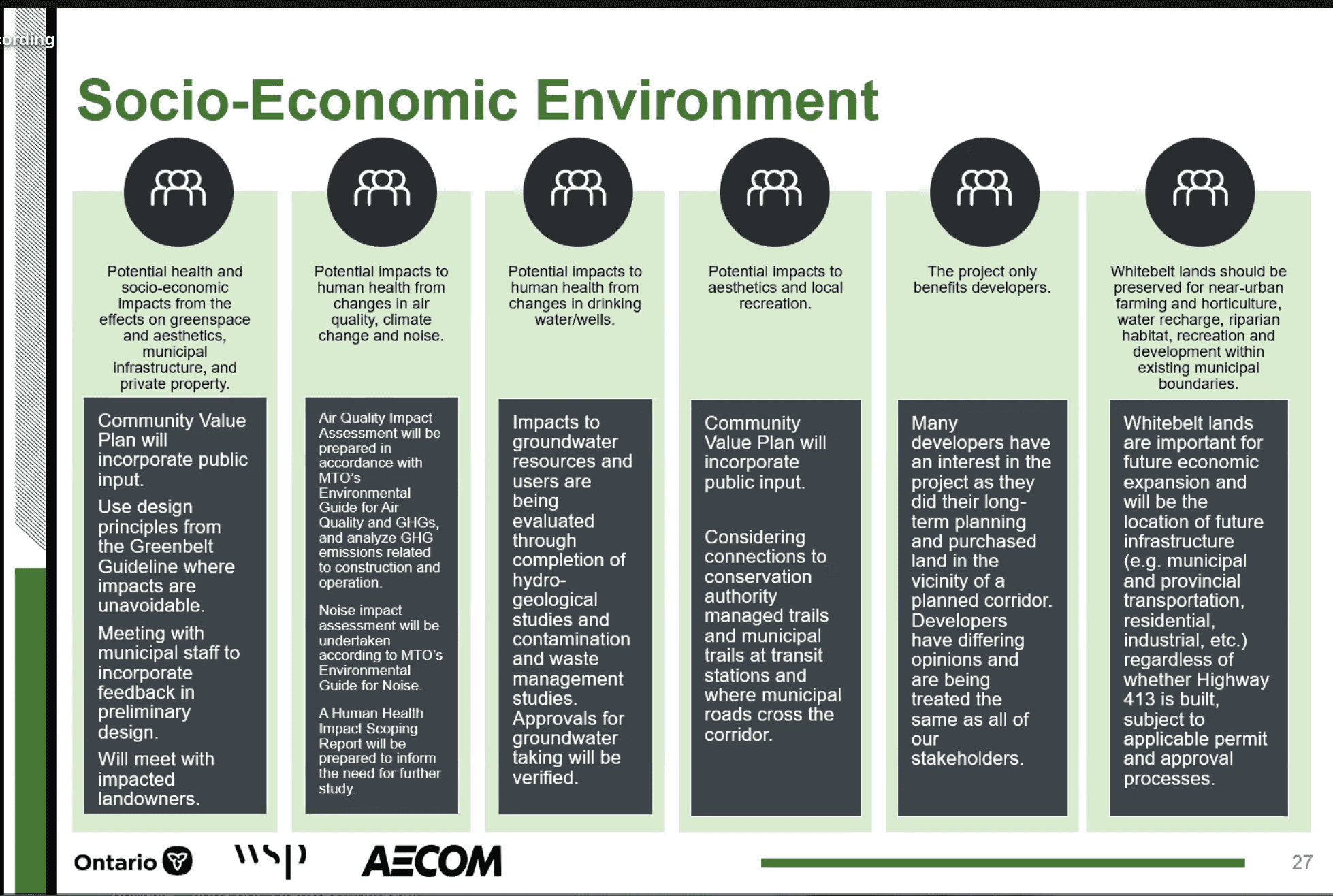The Ontario Ministry of Transportation (MTO) isn’t listening to people and communities.
Last week the Ministry concluded three online Public Information Centres (PICs) to supposedly gather input from people who would be impacted by Highway 413, a proposed mega-highway in the Greater Toronto Area. Instead, the project’s corporate consultants repeated tired inaccuracies, explained away legitimate concerns, and created only the illusion of collecting and considering feedback.
Here are some of the issues I noticed when I attended a PIC.
Little opportunity for input
The Public Information Centres were conducted for residents in Peel Region, York Region, and Halton Region. There were about 450 people in attendance in total, most of whom likely expected to have an opportunity to comment on Highway 413 or ask questions about it.
Neither were made fully possible. The only way to interact with the session was to fill out digital (unscientific) polls or send in digital comments which no one but the hosts could see.
Most problematic was that, as the main host explained at the beginning of the sessions, participant comments would be documented but only “potentially” included in their report.
Throughout the presentation, important questions participants had about the project were not answered, with the exception of a few that the hosts specifically chose to answer at the end.
Surely this cannot be counted as meaningful consultation.

A presentation filled with inaccuracies
The consultants did present a lot of information. But some of what was presented as fact was actually fiction.
For instance, the MTO claimed that greenhouse gas emissions would decrease as a result of the highway being built. This is laughable since everyone knows that building a highway leads to more cars on the road and therefore increased emissions.
Another obvious inaccuracy was the assertion that the highway would lead to a 30-minute time savings on the roads. However, according to an Expert Review Panel, the proposed highway would only save drivers in the region an extra 30-60 seconds.
The MTO’s central position is that the highway is needed – because of population growth forecasts and current road congestion. But population growth does not necessitate more highways. And highways don’t solve congestion. In fact, building a new highway would only lead to more vehicles on the road which would result in congestion once again. This is a well-studied phenomenon called induced demand.
Contrary to the MTO’s “need” argument, our expert study shows that a more efficient and sustainable way to move people is to add public transportation options. An easy and quick solution would be to eliminate tolls on Hwy 407 which is currently underused. It is so underused that a plane used it for an emergency landing in the middle of the day.
It is telling that the previous government’s Expert Panel concluded that there were no significant benefits to proceeding with the 413.
It’s quite the opposite: the highway poses a number of serious problems.
Unsolvable problems
The hosts of the PICs covered a large number of concerns regarding the highway project raised by stakeholders to date. These were promptly glossed over.
For each problem area highlighted, the MTO argued that the issues were either non-issues or were being resolved. The oft-repeated refrain was that the concerns would be studied and/or mitigated – therefore there is nothing to worry about.
But the reality is that:
- You cannot use “design principles” to prevent the destruction of 400 acres of the Greenbelt and over 2,000 acres of prime farmland.
- You cannot prevent the elimination of much-needed greenspace by simply seeking input on the topic.
- You cannot assess away the fact that people living close to the highway will experience respiratory illnesses from the toxic substances emanating from the super highway.
- You can’t credibly promise to meet guidelines around Species at Risk when you are known to routinely ignore them.
- And you certainly cannot study away the fact the highway would impact ceremonial, burial, and archaeological sites of Indigenous communities on whose traditional lands the proposed project would be built.
It’s clear that the MTO is not taking seriously the many problems raised by a variety of stakeholders. The Ministry is simply steamrolling ahead to pave the way for profit-driven development and sprawl.

The solution
Since the Ontario Ministry of Transportation cannot be trusted to collect and consider information from communities and experts, we need an objective impact assessment process which would be grounded in facts, take into account negative impacts, and examine alternative options.
The good news is that the Impact Assessment Agency of Canada will be making a decision on whether this highway project requires a full federal impact assessment in the new year.
We can send them a resounding message of “YES”.
If you haven’t already done so, you can sign our action telling the Ontario government to cancel Highway 413, and we’ll let you know when the Assessment Agency’s comment period begins.
Let’s ensure our voices are heard.









